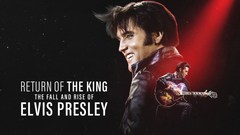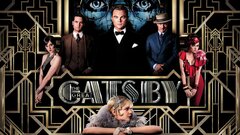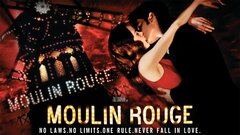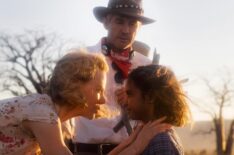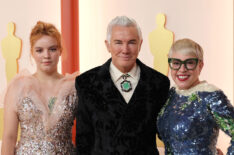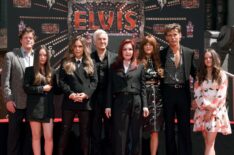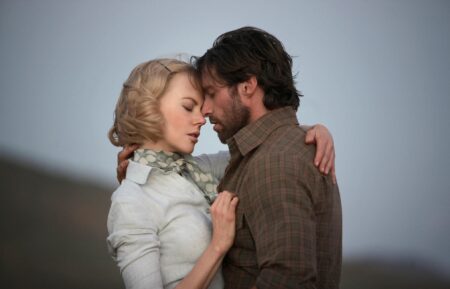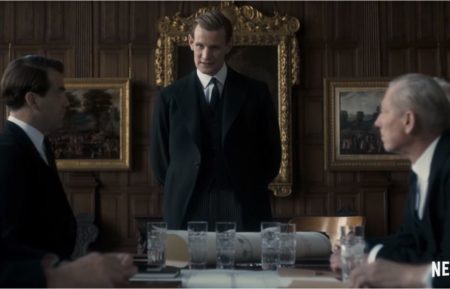Considered one of the most innovative filmmakers working at the turn of the 21st Century, Australian Baz Luhrmann earned that title after having completed only three of his unmistakably stylized, visual gems. Luhrmann found equal measures of detractors and champions for "Strictly Ballroom" (1992), "William Shakespeare's Romeo + Juliet" (1996), and "Moulin Rouge!" (2001), all of which adhered to a specific style developed by Luhrmann and his collaborators that he dubbed "the Red Curtain."
His films relied on straightforward plots, but the world he created was one of heightened reality - visually rich with devices like dance, iambic pentameter, or characters bursting out in song to drive the story. As Luhrmann grew more secure in his position as director and as his budgets increased with each picture, his camera and editing merged into a sort of helter-skelter, hellzapoppin' style that blended the emotional and pictorial in new and revolutionary ways.
Mark Anthony Luhrmann was born on Sept. 17, 1962 in Sydney, Australia. Nicknamed Baz by his beloved father, he spent much of his childhood living in the small rural town of Herron's Creek, where his father operated a gas station, made forays into pig farming, and operated the local movie theater where young Luhrmann became enthralled by the power of storytelling. After his parents' divorce, Luhrmann and his siblings settled with their mother in Sydney.
While still in his teens, he decided to pursue a career as an actor and landed a film role alongside Bryan Brown and Judy Davis in "Winter of Our Dreams" (1981), written and directed by John Duigan. A couple of TV roles followed and Luhrmann enrolled at the prestigious National Institute of Dramatic Arts (NIDA). But, having previously relied on his performer's instincts, Luhrmann found the school's program stifling, and the experience more or less put him off of acting as a career path.
Luhrmann had been nurturing an idea for a one-act piece which he called "Strictly Ballroom," so in 1986, he wrote and staged a 30-minute version. He formed a theater troupe, the Six Years Old Company, which presented a revised and expanded version of "Strictly Ballroom" in 1987 that proved a popular success and toured about Australia. Building on his growing reputation, Luhrmann staged "Dance Hall" (1989), which recreated the look and feel of a 1940s establishment on the night the end of WWII was announced, and earned attention for his progressive "La Boheme" at the Australian Opera, which moved the action to 1950s Paris.
In 1992, Luhrmann made the jump to the big screen with a film version of "Strictly Ballroom." Teaming with screenwriters Andrew Bovell and Craig Pearce, he reworked the material into a comic tale of Australian eccentrics obsessed with the world of competitive ballroom dancing and one individual (Paul Mercurio) who dares to break with tradition by creating his own spontaneous routines. As director, Luhrmann managed to juggle multiple storylines in a manner that kept the audience involved, as well as exhibited a flair for staging scenes, mostly via his now trademark moving camera. He also showed a reliance on using music to move the plot forward. The film was a box-office hit in Australia and a winner of eight Australian Film Institute Awards including Best Picture and Best Director. Upon its American release, "Strictly Ballroom" garnered appreciative critical notices and earned modest returns.
Based on this first appetizing sample of the promising up-and-comer, a revival of Luhrmann's staging of "La Boheme" was filmed in 1993 and aired in the USA on PBS' "Great Performances." Twentieth Century Fox took note of Luhrmann and signed him to a three-year, first-look deal which allowed the filmmaker to make his revisionist take on "William Shakespeare's Romeo + Juliet" (1996). Set in contemporary Florida, the film starred Leonardo DiCaprio and Claire Danes as the Bard's star-crossed lovers who hail from rival gangster families. The film's shooting style was clearly influenced by music videos and Hong Kong actioners and featured stylized settings (designed by Catherine Martin, whom Luhrmann married in 1997) as well as a throbbing alternative music soundtrack.
Through it all, Luhrmann stayed true to Shakespeare with the use of improbable (yet arguably successful) iambic pentameter from the original play. American reviewers were divided over its merits, but the film found an audience, thanks to its attractive young cast and its visual razzle-dazzle, raking in more than $45 million in domestic grosses.
Luhrmann's development time between films was typically three years, and "Moulin Rouge!" (2001) was no exception. Again he collaborated with Craig Pearce to craft the screenplay, creating a large-scale movie musical set at the end of the 19th Century and based partly on the Orpheus myth, as well as drawing on "La Boheme" and other sources. "Moulin Rouge!" premiered at Cannes to appreciative audiences, but a divided critical response.
The film's lavish production design, colorful costumes, and overblown style appealed to many, while others found fault with the thin plot. Few had quibbles with stars Nicole Kidman, Ewan McGregor, and Jim Broadbent - all of whom did their own singing - and nearly all agreed that if nothing else, "Moulin Rouge!" helped to revitalize a moribund art form. In the wake of "Moulin Rouge!" mania, Luhrmann brought his adaptation of "La Boheme" to Broadway, where it enjoyed a six-month run and Luhrmann and the musical were both nominated for Tony Awards.
His wife again walked off with a statue for her scenic design.
In 2003, Luhrmann directed a typically lavish, multi-million-dollar commercial for Chanel N° 5 titled, "N° 5 the Film," starring Nicole Kidman and Rodrigo Santoro - the look of which was very "Moulin Rouge"esque. After investing some time in an aborted film project about Alexander the Great, he returned to theaters a full five years later with "Australia" (2008), Luhrmann's take on the sweeping historic epics of classic-era Hollywood set in World War II Australia. Critics were split over whether this melodrama starring Nicole Kidman and Hugh Jackman lived up to the "Gone with the Wind" (1939) epic-like expectations, but most agreed that the film was a standout alone for its gorgeous landscapes and visuals.
